Movement Efficiency: Optimising Biomechanics and Performance
Updated On: August 23, 2025 by Aaron Connolly
Understanding Movement Efficiency
Movement efficiency is all about using as little energy as possible to get the job done, while still getting great results. Striking that balance between energy conservation and performance matters for everyone, from casual gamers to pro esports players who spend hours perfecting their movements.
Definition and Core Principles
When we talk about movement efficiency, we mean doing physical tasks with the least amount of energy wasted and the most effectiveness. We try to use the right muscles at the right time, in the right order, to create smooth, coordinated actions.
Biomechanics sits at the heart of this—it’s how our muscles, bones, and joints work together to make us move. If everything lines up, we waste less effort and avoid putting extra strain on our bodies.
Key elements include:
- Proper joint alignment
- Muscle balance and coordination
- Optimal force transmission
- Timing of muscle activation
Picture a pro gamer’s hand position during a tense match. Efficient movement lets them keep up precise control for hours, without burning out or risking injuries.
Significance for Health and Performance
Efficient movement brings three big perks: better performance, energy savings, and more safety. These benefits matter whether you’re gaming for hours or just going about your daily routine.
Performance benefits include:
- Less fatigue in long sessions
- Quicker recovery between activities
- Improved endurance over time
- Sharper control and accuracy
For esports athletes, movement efficiency can make or break their edge. Bad posture or sloppy movements slow down reaction times and mess with accuracy.
Moving efficiently helps you save energy for when it really counts—like those clutch moments in a game or heavy lifting in real life.
Efficiency Versus Effectiveness
Efficiency and effectiveness aren’t quite the same thing. Efficiency is about using as little energy as possible to finish a task. Effectiveness is about actually getting the result you want, even if it costs more energy.
| Aspect | Efficiency | Effectiveness |
|---|---|---|
| Focus | Energy conservation | Result achievement |
| Measurement | Energy per unit of work | Goal completion rate |
| Priority | Resource management | Outcome quality |
You might finish a task and call it effective, but if your technique is sloppy, you’re probably wasting energy. On the flip side, you could move super efficiently but never hit your actual goal.
Ideally, you want both. Efficient movement gives you the foundation for effective performance, making your approach sustainable for physical activity or gaming.
Biomechanics and Movement Quality
Good biomechanics lay the groundwork for efficient movement. They make sure you’ve got joint alignment, smooth force transfer, and muscles firing in sync.
Joint Alignment and Force Transmission
Joint alignment controls how forces move through your body. When your joints stack up right, forces flow efficiently from one part to the next.
If your alignment is off, energy leaks out and your body has to work harder for the same result.
Optimal alignment patterns include:
- Neutral spine positioning
- Knee tracking over toes
- Hip and shoulder stability
Force moves best when joints stay in their natural positions. If something’s out of line, nearby muscles have to pick up the slack, which kills efficiency.
Take a squat, for example. When your ankles, knees, and hips line up, force travels smoothly upward. If your knees cave in, energy escapes sideways instead of helping you stand up.
You’ll see this principle in any movement, from walking to more athletic stuff.
Kinetic Chain Dynamics
The kinetic chain is how all your body parts connect and influence each other when you move. Each joint and muscle group affects the next one in the line.
Movement depends on timing between segments. If one part of the chain messes up, the whole movement gets thrown off.
Key chain relationships:
- Foot position affects knee alignment
- Hip mobility influences spine movement
- Shoulder blade position impacts arm function
Look at throwing. Power starts from the ground, runs through the legs and hips, then the core and shoulder, and finally out through the arm.
If any part is out of sync, you lose power or control. Your core might be strong, but if your hips don’t drive, your throw just won’t have that snap.
Understanding these links can help figure out why certain movements feel awkward or hard.
Impact of Muscle Balance
Muscle balance matters more than just being strong. If you’ve got imbalances, your body compensates in weird ways, which makes you less efficient and more likely to get hurt.
Common imbalance patterns:
- Tight hip flexors with weak glutes
- Overactive upper traps with weak deep neck muscles
- Dominant quads with underactive hamstrings
These imbalances mess with your normal movement. Your brain tries to help by recruiting other muscles, but that just creates new problems.
After a while, compensations become your go-to way of moving. Fixing this takes targeted strength work for weak spots and mobility for tight areas.
Balanced muscles work together. Each one does its job, so nothing else has to pick up the slack.
Regular movement assessment can catch imbalances before they mess with your performance or cause pain.
Movement Patterns and Practical Application
Movement patterns sit at the core of everything we do, from climbing stairs to pulling off complex skills. Figuring out how we build and refine these patterns is key if you want to move more efficiently.
Fundamental Human Movements
We all have basic movement patterns that form the backbone of everything else. These include squatting, lunging, pushing, pulling, and rotating.
Squatting means bending at the hips and knees while keeping your torso upright. You use it to sit down, pick things up, or climb stairs. Ankles, knees, and hips all work together for smooth movement.
Pushing and pulling are everywhere. Opening doors, lifting bags, even reaching overhead—they all use these patterns. Your shoulders, arms, and core work as a team to move things efficiently.
Walking and running are our go-to ways to get around. Your legs alternate, your arms swing, and your whole body acts as one system to move you forward.
| Movement Pattern | Daily Examples | Key Joints |
|---|---|---|
| Squat | Sitting, lifting | Hips, knees, ankles |
| Push | Opening doors | Shoulders, elbows |
| Pull | Lifting bags | Shoulders, elbows |
| Rotate | Turning around | Spine, hips |
Natural Versus Learned Patterns
Some movement patterns just show up as we grow, while others need specific practice. Natural movements develop as we explore and play.
Natural movement covers things like crawling, walking, and reaching. Babies don’t need lessons to crawl—they pick it up by messing around and playing.
But lots of efficient movement patterns only come with learning and practice. Sports, dance, even lifting right all take focus and repetition. Our brains can learn these, but it takes focused attention.
Natural movements help us survive. Learned patterns are usually more complex and help us achieve specific goals, like nailing a tennis serve or sticking a landing.
Environment also shapes how we move. Someone who grows up on rocky ground moves differently than someone raised on flat sidewalks.
Deliberate Practice in Skill Acquisition
Getting better at movement isn’t just about repeating stuff over and over—it’s about practising with purpose and feedback.
Quality over quantity is the real game-changer. If you keep practising something the wrong way, you only lock in bad habits. Focusing on good technique from the start pays off.
The best practice breaks complex moves into smaller parts. Learning to throw well? Work on your grip, arm position, and follow-through separately before putting it all together.
Immediate feedback helps your brain adjust quickly. This could come from a coach, a video, or just listening to your own body. You need to know what worked and what didn’t.
Keep challenging yourself. Once you master the basics, add speed, weight, or complexity. Progressing step by step keeps things manageable and helps you keep improving.
Mental rehearsal counts too. Visualising perfect moves strengthens the brain pathways you’ll use in real life.
Mobility and Range of Motion
Good mobility and a full range of motion are what make movement smooth and efficient. If you pick the right kind of stretching and know your limits, you’ll notice a big difference in how you move.
Mobility as a Key to Efficiency
Mobility isn’t just flexibility—it’s flexibility plus strength and control through your whole range. Passive stretching is fine, but mobility means you control your movement at every angle.
With solid mobility, your joints move freely and nothing holds you back. You don’t waste energy fighting against stiffness.
Active mobility needs strength at the end of your range. Your hip flexors, for example, need both length and strength to lift your knees efficiently when you run.
If your mobility stinks, your body compensates and burns more energy. Limited ankle mobility? Your knees and hips have to pick up the slack during squats or lunges.
Studies show functional mobility cuts injury risk by 23% compared to just flexibility work. Our bodies move as one chain, not as isolated parts.
Key mobility benefits:
- Better force transfer between joints
- Less wasted energy
- Improved joint alignment and muscle firing
- Enhanced performance in everything you do
Dynamic Versus Static Stretching
Dynamic stretching means moving through ranges of motion. Static stretching is about holding a position for a while.
Dynamic stretching works best before you get active. Things like leg swings, arm circles, and walking lunges get your muscles and nervous system ready.
You’ll get more blood flow and your muscles will be more responsive.
Static stretching is better for winding down after a workout. Holding stretches for 30-60 seconds helps muscles relax and lengthen.
Pre-activity routine:
- 5-10 minutes of dynamic moves
- Motions that match your sport or activity
- Gradually increase range and speed
Post-activity routine:
- 10-15 minutes of static holds
- Focus on tight spots
- Deep breathing helps muscles relax
Dynamic warm-ups boost performance by 3-7% compared to static stretching before exercise. Not bad, right?
Range of Motion Limitations
Lots of things can limit your range of motion—joint structure, tight muscles, and old injuries all play a part.
Muscle restrictions are usually the easiest to fix. Tight hip flexors from sitting too much can limit hip extension when you walk or run.
Fascial restrictions are trickier. This connective tissue can get stiff and hold back whole groups of muscles.
Joint issues from arthritis or injuries need different strategies. Sometimes you just have to work around them instead of pushing for more range.
Common problem areas:
- Shoulders: rounded posture limits reaching overhead
- Hips: sitting tightness makes deep squats tough
- Ankles: stiffness makes running less efficient
- Thoracic spine: hunching reduces rotation
As we age, our range of motion drops by about 6-8 degrees per decade in big joints. Regular mobility work can slow that down a lot.
Heads up: Pushing through pain to get more range usually backfires and makes things tighter.
Role of Proprioception and Neuromuscular Control
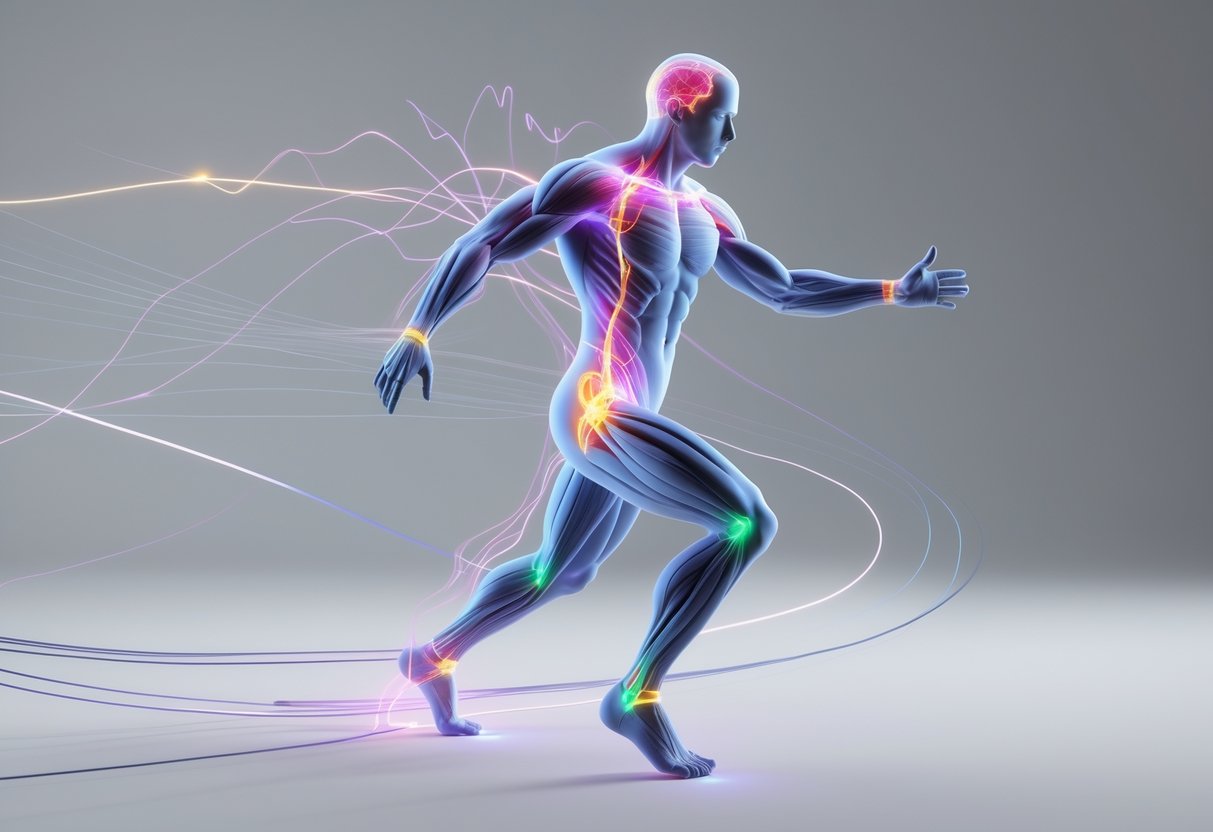
Proprioception acts like your body’s internal GPS, letting your muscles know exactly where they are in space. Neuromuscular control takes that info and turns it into smooth, accurate movements that keep you balanced and coordinated.
Proprioceptive Feedback Systems
Your proprioceptive system acts as a constant feedback loop between your brain and body. Sensors in your muscles, tendons, and joints send non-stop messages about your position.
These sensors pick up on things like your foot landing on uneven ground or when you lean a bit too far forward. Your brain grabs that info right away and shoots corrective signals back to your muscles.
The system has three main parts:
- Muscle spindles that sense stretch and length changes
- Golgi tendon organs watching muscle tension
- Joint receptors tracking joint position and movement
When your proprioceptive system fires on all cylinders, you can walk over rough ground without glancing down. You adjust your balance automatically if someone bumps into you.
Your body makes these fixes before you even realize what’s happening.
If your proprioception isn’t great, you’ll probably move clumsily and risk more injuries. Athletes with sharper proprioceptive skills move efficiently and don’t waste energy on pointless corrections.
Neuromuscular Coordination for Precision
Neuromuscular coordination is basically your nervous system and muscles teaming up to create precise movement. This partnership shapes how smoothly and accurately you move.
Your brain figures out how to fire the right muscles at just the right time. Strong muscles alone won’t help if they work too early, too late, or out of order.
Good coordination depends on:
- When your muscles activate
- Matching force to what the task needs
- Smooth shifts between movement phases
Training speeds up the nerve signals that reach your muscles. Faster signals mean you react quicker and control movements better.
That’s why experienced athletes can tweak their actions in a split second—something beginners just can’t do.
Practice builds motor patterns that eventually run on autopilot. Your nervous system remembers what works and can repeat it with less focus, freeing up your mind for other things during tough activities.
Improving Balance and Stability
Balance training teaches your proprioceptive and neuromuscular systems to work together more smoothly. Even simple exercises can make a real difference in stability and control.
Useful balance training methods:
- Single-leg stands with eyes closed
- Unstable surface drills with wobble boards
- Dynamic moves that challenge different planes
- Drills tailored to your sport
Start with basic static holds. Try holding a single-leg stand for 30 seconds with your eyes open, then go for it with your eyes closed. That really makes your proprioceptive system hustle.
When you use unstable surfaces like foam pads or balance boards, your stabilising muscles have to keep making tiny adjustments. That builds up those small, deep muscles that keep your core steady.
Dynamic balance exercises are closer to what you face in real life. Try walking heel-to-toe on a line, then backwards, or throw in some head turns. These challenges help you stay in control when things get unpredictable.
Strength and Conditioning Foundations
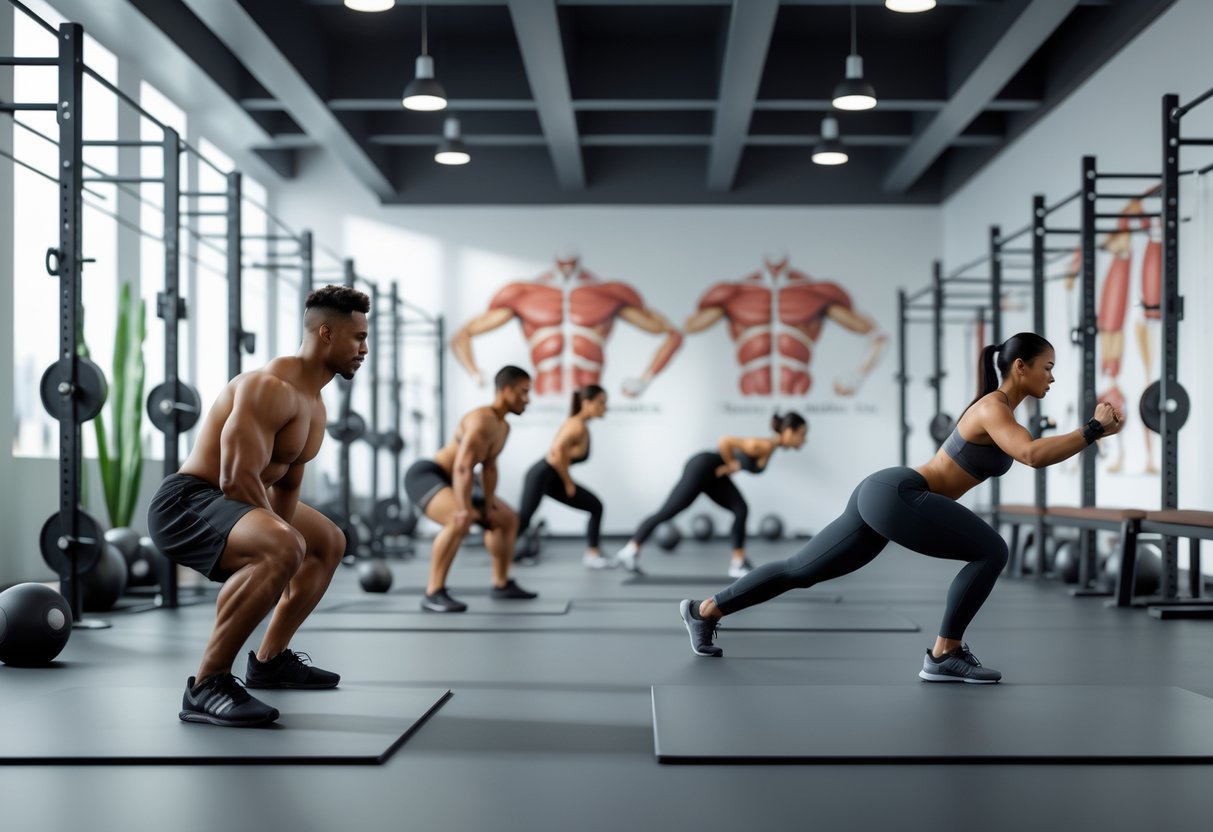
Building efficient movement starts with proper strength training. This develops force and teaches your body how to transfer power between muscle groups.
These basics lay the groundwork for every athletic movement.
Strength Training for Efficiency
Strength training isn’t just about piling on muscle. It’s about developing neuromuscular efficiency—using your muscles in the smartest way possible.
Foundation movement skills open the door to lasting fitness. These basic patterns teach your body to move right before you add any weight or speed.
Key Foundation Movements:
- Squats
- Hip hinges
- Push and pull motions
- Core stabilisation
Your muscles have to work together as a team. Training just one muscle at a time misses out on the coordination that makes movement efficient.
Progressive overload matters, but you have to be smart about it. Start with bodyweight moves and nail the pattern before you add resistance.
Training Priorities for Efficiency:
- Movement quality first—get the form right before adding weight
- Strength-endurance base—build up for repeated efforts
- Sport-specific adaptations—train movements that fit your sport
Recovery and personal tweaks are just as important as the training itself. What works for someone else might not fit your body.
Power and Energy Transfer
Power training builds on your strength base and adds speed for explosive movement. Here, you learn to transfer energy efficiently through your whole body.
The force-velocity relationship is key. Heavy, slow moves build strength, while light, fast ones boost speed. You need both to hit peak power.
Power Training Methods:
- Plyometrics for reactive strength
- Olympic lift variations for explosive power
- Medicine ball throws for rotation
- Sprint drills for horizontal force
Energy transfer works through kinetic chains—linked body parts passing force along, like when you throw a ball or jump up for a header.
Your fascia and connective tissue act like springs, storing and releasing energy as you move. Training these systems gives your movement some bounce and cuts down wasted energy.
Effective Power Sequences:
- Generate force from the ground up
- Transfer through your core
- Let your limbs express the power
Periodisation helps you build these qualities step by step. You can’t train max strength and speed at the same time, so you break your training into phases through the year.
Energy Conservation in Movement
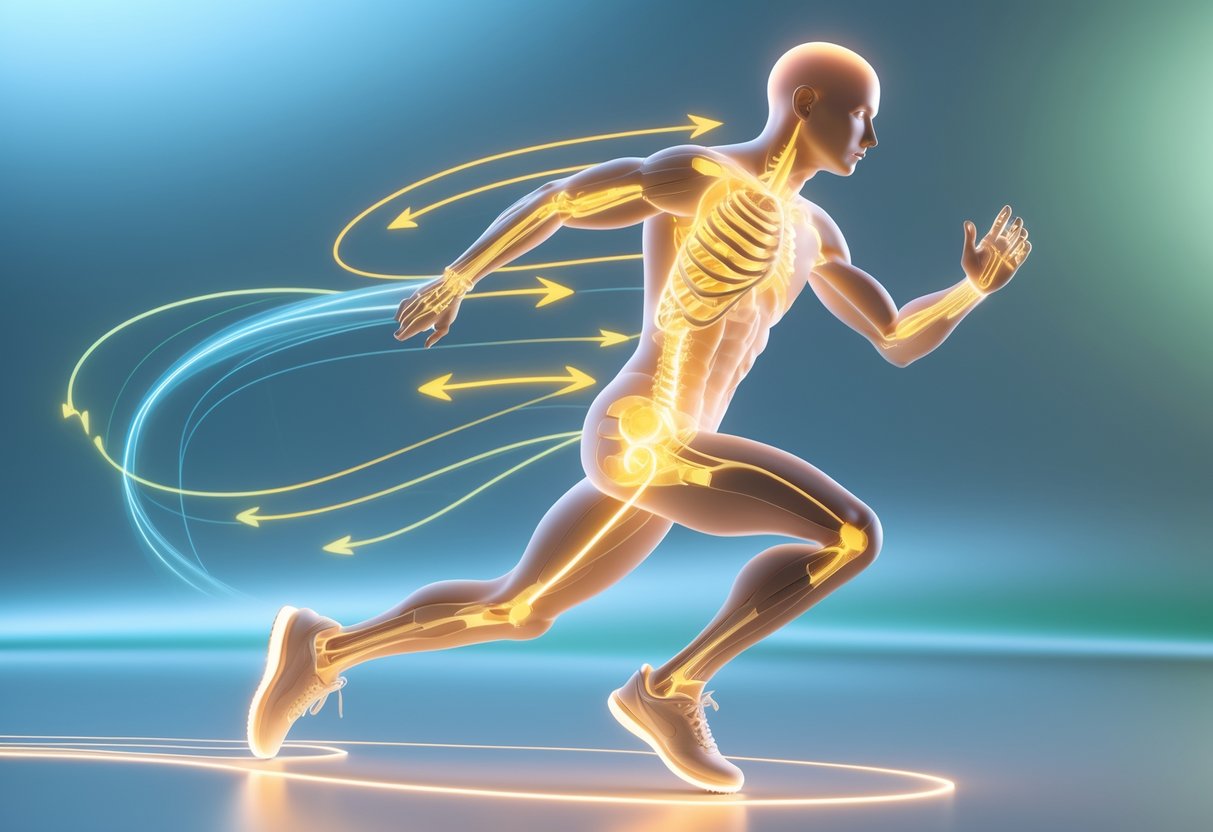
Efficient movement is all about using less energy to get more done. Smart energy management means cutting out wasteful habits and using sport-specific techniques to save stamina when you need it.
Strategies for Reducing Energy Waste
Proper alignment keeps you from wasting energy. When your joints stack the right way, you don’t need extra muscle effort and gravity actually helps you out.
If you slouch, your body calls in backup muscles that tire you out before you even start moving.
Breathing patterns have a big effect on energy use. Shallow chest breathing burns energy and doesn’t get enough oxygen to your muscles.
Deep belly breathing gets you more oxygen with less effort. Try to breathe from your diaphragm, not your chest.
Timing your movement stops energy leaks. When your muscles work together at the right time, each part of your body does its job.
If muscles fire out of order, they end up fighting each other. That just wastes energy and kills your power.
Signs of efficiency:
- Smooth transitions between moves
- Little to no extra muscle tension
- Natural rhythm for the task
- Less effort during familiar activities
Techniques for Endurance Sports
Cadence optimisation lets endurance athletes find their most efficient groove. Everyone has a pace that uses less energy per mile or kilometre.
Runners often do better with higher cadences—it can cut down muscle damage. Cyclists might pick lower cadences, depending on the ride and their fitness.
Elastic energy storage lets you recycle energy with each step or pedal. Tendons and fascia store energy and give it back in the next movement.
Landing with soft, bent knees helps you catch that elastic bounce. If you land stiff, you lose that free energy.
Pacing strategies help you avoid running out of steam too early. Keeping your effort steady usually beats going out fast and fading later.
Energy conservation tips for endurance:
- Drafting: Cuts wind resistance by 20-30%
- Negative splits: Start slower, finish faster
- Fuel timing: Eat carbs before you run out of energy
- Recovery intervals: Take short breaks during long efforts
Practise these often so they become second nature in competition.
Injury Prevention Through Efficient Movement
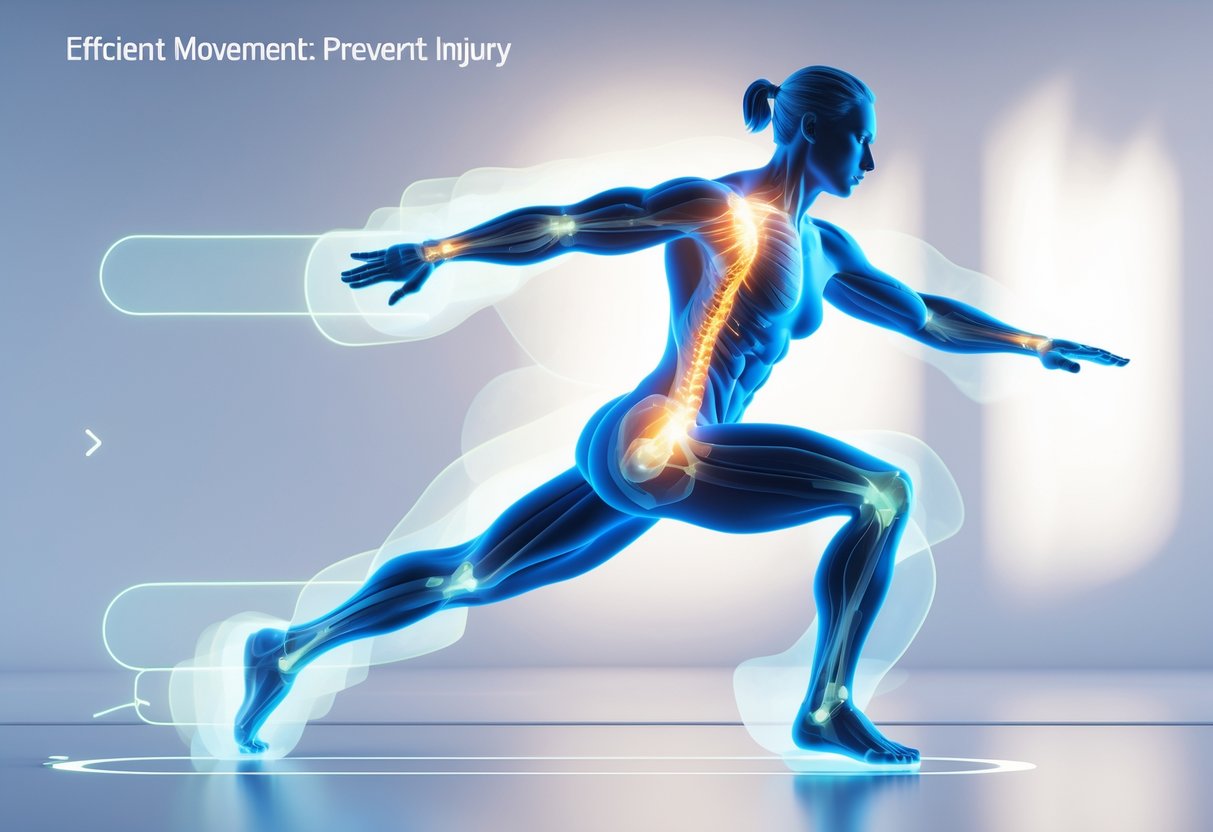
Bad movement patterns put extra stress on your joints and muscles. This can lead to sudden injuries or long-term wear and tear.
If you spot risky patterns early and fix them the right way, you can cut down injury risk during training and competition.
Identifying Risky Movement Patterns
A few movement habits seriously raise your injury risk in different activities. These patterns usually sneak in over time and stick because you repeat them.
Forward head posture strains your neck and shoulders. Your upper back muscles have to work harder, and the deep neck stabilisers get weaker.
Knee valgus—when your knees cave in during squats or landings—puts dangerous stress on your ACL and meniscus. The knee should track over your toes, not fall inward.
Anterior pelvic tilt tightens your hip flexors and weakens your glutes. That ramps up lower back stress during lifting or running.
Rounded shoulders limit how far you can reach overhead and set up rotator cuff injuries. Your chest gets tight, and your upper back grows weak.
Watch for these warning signs:
- Joint pain during certain moves
- Muscle tightness on just one side
- Less range of motion than usual
- Getting tired early in exercises you know
Minimising Injury Risk in Training
To lower your injury risk, focus on technique before intensity, especially when learning new movements.
Start with bodyweight exercises. Get your squats, lunges, and planks dialed in before picking up weights.
Stick to the 10% rule for progress. Only bump up your intensity, duration, or load by 10% each week so your body can keep up.
Add mobility work to every session. Do dynamic stretches before you start, and static stretches when you’re done to keep your joints moving well.
Strengthen both sides. Balance push moves with pulls, and work both your quads and hamstrings.
Key injury prevention tips:
- Warm up for 10-15 minutes
- Check your movement quality often
- Give yourself enough recovery time
- Build up training slowly, not all at once
Monitoring and Correction Methods
Regular check-ins and corrections help you catch small issues before they turn into big injuries. Simple tests and feedback can keep your movement on track.
Use video analysis to spot flaws you might not feel. Record yourself from different angles and compare with good technique.
Monitor pain levels during exercises. Rate your pain from 1-10 and avoid anything higher than 3-4.
Test your range of motion to catch tight spots early. Check your shoulders, hips, and ankles at least once a month.
Functional movement screens test basic moves like squats, lunges, and reaching overhead. These can show you where you’re compensating or out of balance.
To fix problems:
- Stretch tight muscles
- Strengthen weak spots
- Use motor control drills to build better patterns
- See a pro if you can’t fix it yourself
Beginners should check themselves every week. More experienced athletes can do it monthly. Keep notes on what gets better or worse over time.
Muscle Activation and Functional Training
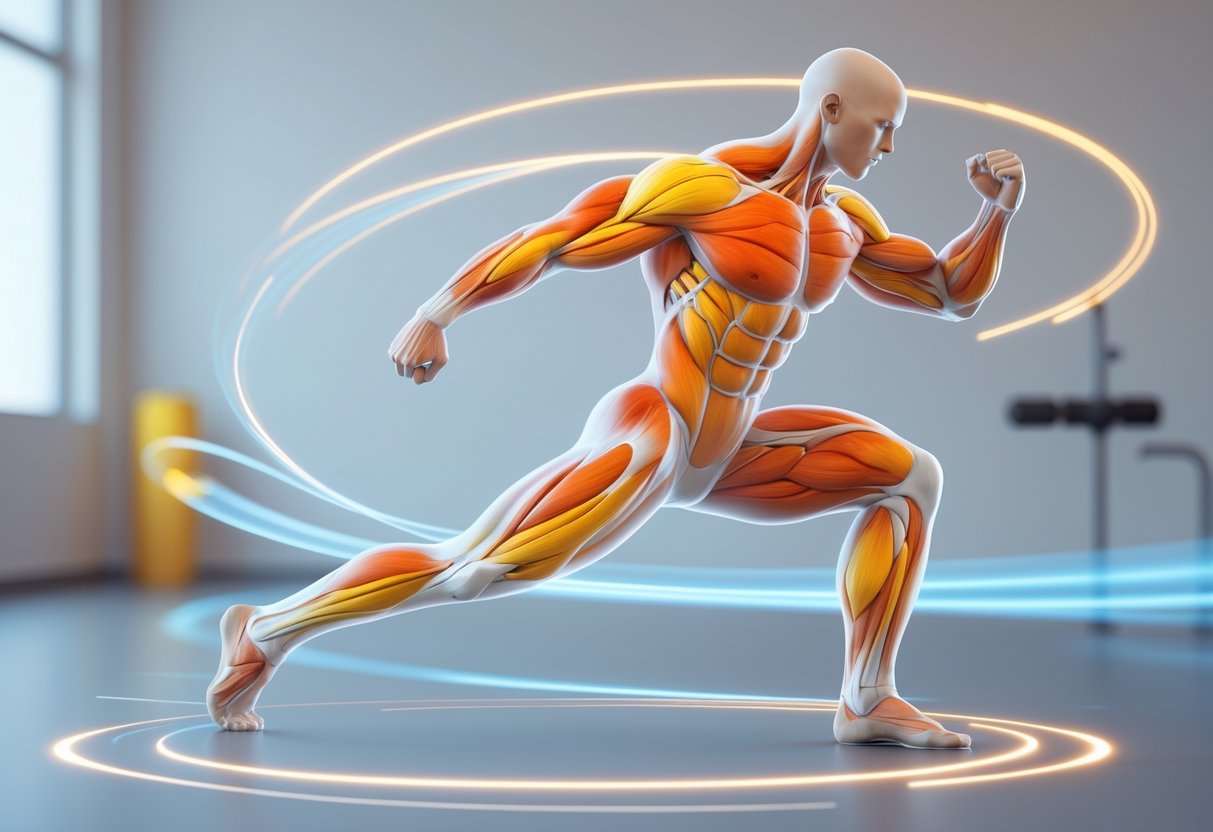
Muscle activation during functional training is a whole different game compared to isolated exercises. You build better coordination between muscle groups this way.
To get the most out of functional training, you need to understand how muscles work together and practise drills that sharpen this teamwork.
Principles of Muscle Recruitment
When you move functionally, your nervous system calls on several muscles at once instead of working them one at a time. This neuromuscular efficiency lets you move smoother and waste less energy.
The central nervous system sets up muscle recruitment patterns for real-world actions. Primary muscles do the heavy lifting, while stabilising muscles keep you balanced.
Traditional training usually targets just one muscle. Functional training mimics real life by making several muscle groups work together.
Key recruitment principles:
- Core muscles fire up first to stabilise your spine
- Movement starts from your centre and moves out to your limbs
- Opposing muscles work together for control
- Timing is just as important as strength
Beginners often lean too much on the wrong muscles. For instance, someone new might overuse their back instead of letting their core lead.
That kind of pattern wastes energy and can set you up for injury.
Drills for Improved Muscle Activation
Basic activation drills teach you how to recruit the right muscles before things get complicated or heavy.
Dead bug exercises get your core working while you move your arms and legs independently. Lie on your back, knees bent at 90 degrees. Lower your opposite arm and leg slowly, and try to keep your back flat.
Bird dog movements challenge your core stability and coordination. Start on your hands and knees, then reach out with your opposite arm and leg. Hold for five seconds, then switch sides.
Glute bridges wake up your posterior chain. You might notice your back tries to do the work—focus on getting your glutes to take over during hip lifts.
Progressive training approaches:
- Move slowly and keep things controlled at first.
- Try unstable surfaces like balance boards.
- Mix upper and lower body patterns.
- Pick up the speed, but don’t lose control.
Warning: If you rush these drills, you’ll miss the point. Slow down and tune in to the muscles you’re supposed to feel—don’t just count reps.
Try these drills three to four times a week before your main workouts. Most folks start to feel more coordinated in two or three weeks if they stick with it.
Athletic Performance and Sport-Specific Application
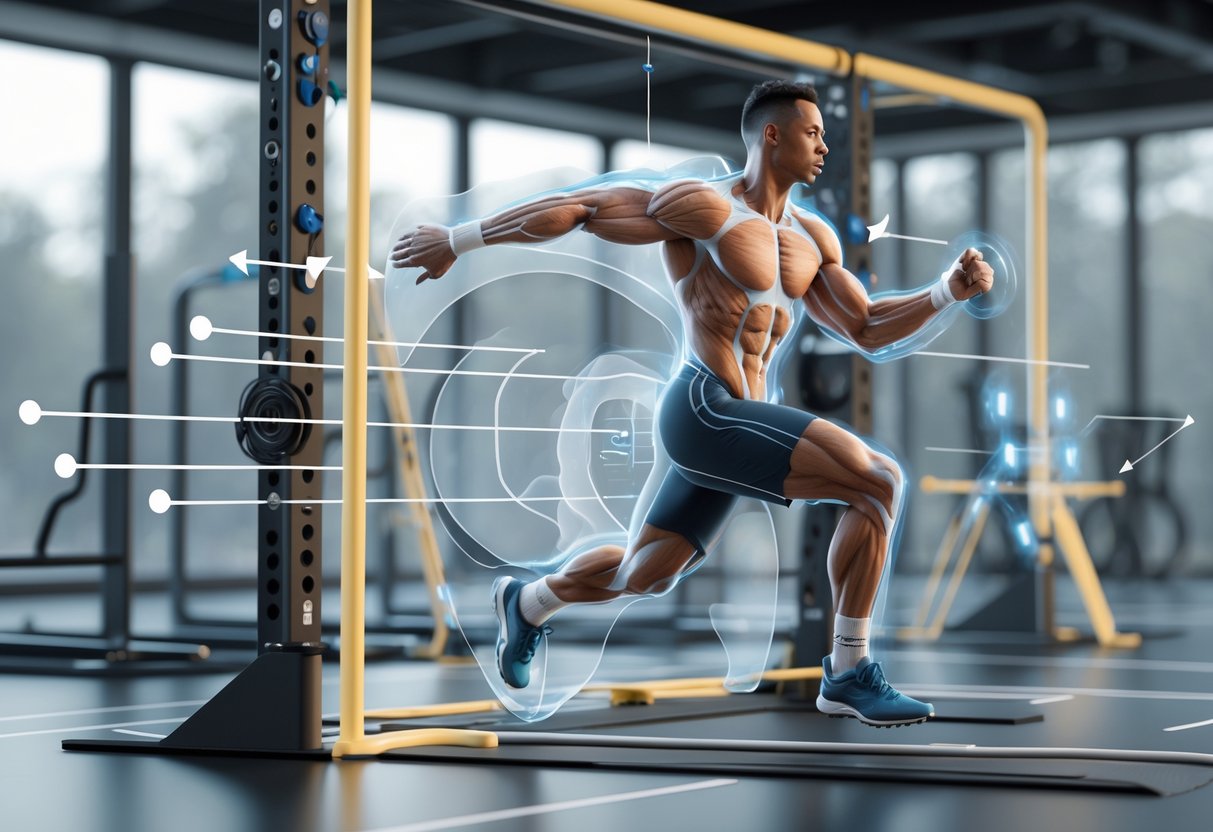
Athletes in every sport can boost their performance by understanding how their bodies move best. Each sport really does have its own movement quirks, so training needs to match those demands.
Movement Efficiency for Athletes
Biomechanics gives athletes insight into how forces like acceleration and friction actually affect them during competition. When you move efficiently, you use less energy and keep going longer.
Sports scientists track how athletes use their energy for certain actions. This data highlights which movements waste energy and which ones help you save it for the moments that count.
Elite athletes often win because they’ve nailed down efficient movement. For example, a runner with good form might use 10–15% less energy than someone with sloppy technique. That’s a huge difference over a long race.
Movement efficiency training usually focuses on three things:
- Joint mechanics—how your bones and muscles work together
- Energy conservation—cutting out wasted movement
- Force production—getting the most power with the least effort
Athletes who work on movement efficiency can see performance gains in four to six weeks. The improvements might seem minor at first, but they add up fast in competition.
Examples from Different Sports
Every sport needs its own movement strategies. What works in swimming won’t help a footballer, and runners move differently than tennis players.
Swimming is all about reducing drag and getting the most out of each stroke. The best swimmers stay horizontal and use long, smooth movements. Bad form can slow you down by 20–30 seconds over 100 meters—ouch.
Running efficiency comes down to cadence and how your foot hits the ground. Elite marathoners usually keep about 180 steps per minute and don’t bounce much. This saves them energy for the last stretch.
Football players rely on efficient cutting and quick acceleration. Good technique can cut knee injuries by up to 40% and help players explode off the line faster.
| Sport | Key Efficiency Factor | Performance Gain |
|---|---|---|
| Swimming | Stroke length | 15-25% faster times |
| Running | Cadence control | 10-20% energy saving |
| Football | Cutting technique | 30% fewer injuries |
| Tennis | Service motion | 20% more power |
Tennis serves really show how biomechanics can make a difference. Players who connect their legs, trunk, and arms just right can add 15–20 mph to their serves.
Individualised Training Approaches
Every athlete brings a different set of strengths, weaknesses, and body mechanics to the table. Generic training just doesn’t cut it.
Movement analysis uncovers each athlete’s unique patterns. Some runners overstride, while others have weak hips. These issues need targeted solutions, not cookie-cutter plans.
Assessment usually includes:
- Video analysis of your technique
- Force plate measurements
- Flexibility and strength tests
- Sport-specific movement screens
Coaches then build training plans based on what you actually need. A swimmer with tight shoulders trains differently than one with a weak core.
Effective individualised programmes usually:
- Assess your movement patterns
- Spot specific weaknesses
- Build targeted exercises
- Check your progress regularly
- Adjust the plan as you improve
Athletes who work with movement specialists often see 20–30% better performance. The trick is to match training to your body, not someone else’s.
Technology makes custom training easier than ever. Wearable sensors track your movement during real training, giving you feedback that used to require a lab.
Tools and Technology for Analysing Efficiency
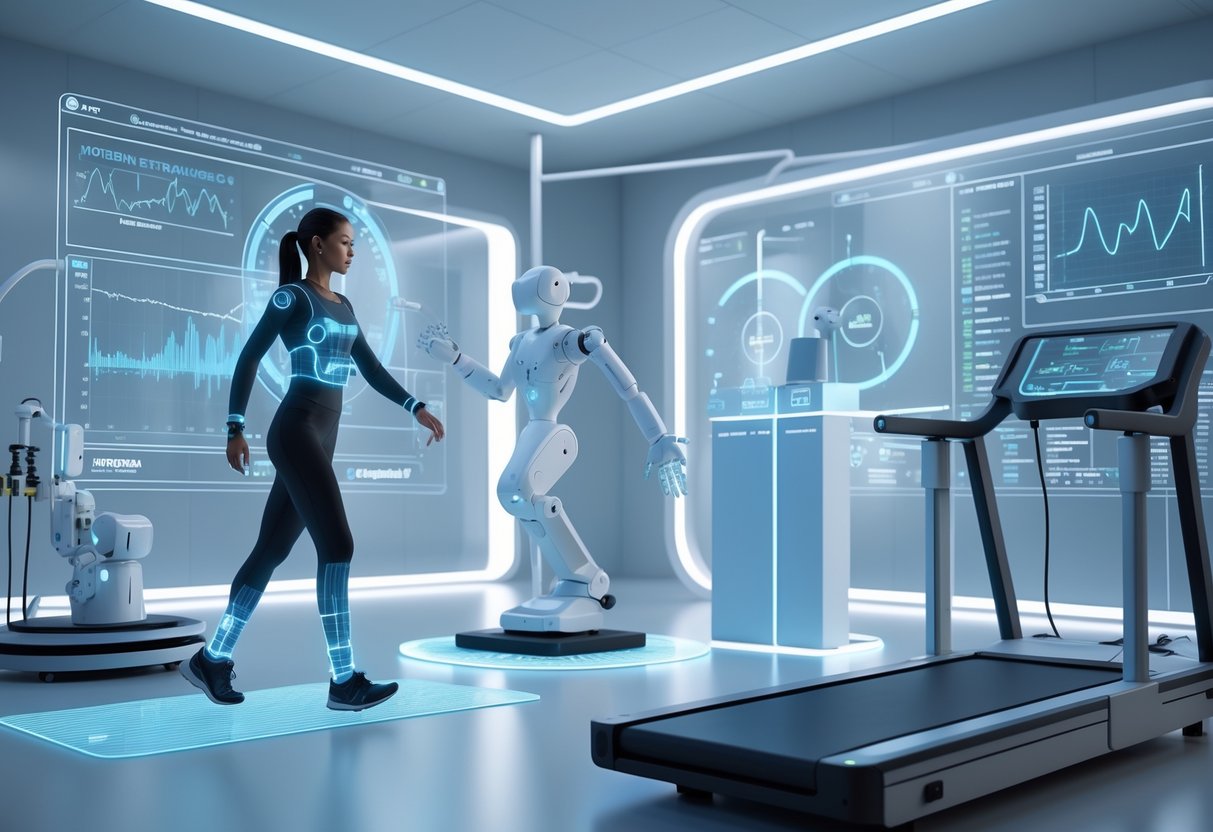
Modern tech has totally changed how we look at movement in competitive gaming. Motion capture systems now track body positions during play, and wearable sensors give you live feedback on posture and muscle tension.
Motion Capture Systems
Marker-based systems like Vicon still set the standard for movement analysis. They use reflective markers on your body to track joint angles and posture.
But markerless options are catching on. Cameras such as Microsoft’s Azure Kinect use AI to spot your body’s landmarks—no sticky markers required. This makes the process quicker and less of a hassle.
Why markerless systems are catching on:
- No need to spend time placing markers
- You can move naturally, no restrictions
- Portable—use them outside the lab
- Cheaper than traditional systems
Gamers use these tools to analyse mouse movement, keyboard setup, and chair ergonomics. Some esports centers even use them to tweak player setups and prevent repetitive strain injuries.
Wearable Sensors and Feedback
Inertial measurement units (IMUs) offer lightweight, real-time tracking for movement efficiency. These little gadgets use accelerometers and gyroscopes to keep tabs on you during long sessions.
Today’s wearables can track:
- Posture changes over long practices
- Muscle tension in your shoulders, neck, and wrists
- Breathing patterns during stressful moments
- Movement frequency and repetitive actions
Companies like dorsaVi have built sensor suites just for movement analysis. Their apps give instant feedback, so you can tweak your posture on the fly.
Some practical uses:
- Vibration alerts if your posture slips
- Break reminders when tension builds
- Tracking how your physical state affects performance
- Long-term health monitoring
Biomechanical Assessment in Practice
A full biomechanical assessment mixes several technologies to create a detailed movement profile. Esports teams are starting to use these tools to keep players healthy and performing well.
A typical assessment uses force plates for chair positioning, electromyography for muscle activity, and video for movement patterns. This data helps spot inefficiencies and avoid injuries.
The assessment process often looks like this:
| Stage | Technology Used | Duration |
|---|---|---|
| Initial screening | Video analysis | 30 minutes |
| Detailed measurement | Motion capture + sensors | 60 minutes |
| Data analysis | Biomechanical software | 2-3 hours |
| Recommendations | Custom report | 1 week |
Results can be eye-opening. Many pros find out they’re using extra muscle tension or holding awkward positions during key moments.
Teams like Fnatic and Cloud9 now have biomechanics specialists on staff. This approach has helped reduce injuries and keep performance steady through long tournaments.
Frequently Asked Questions
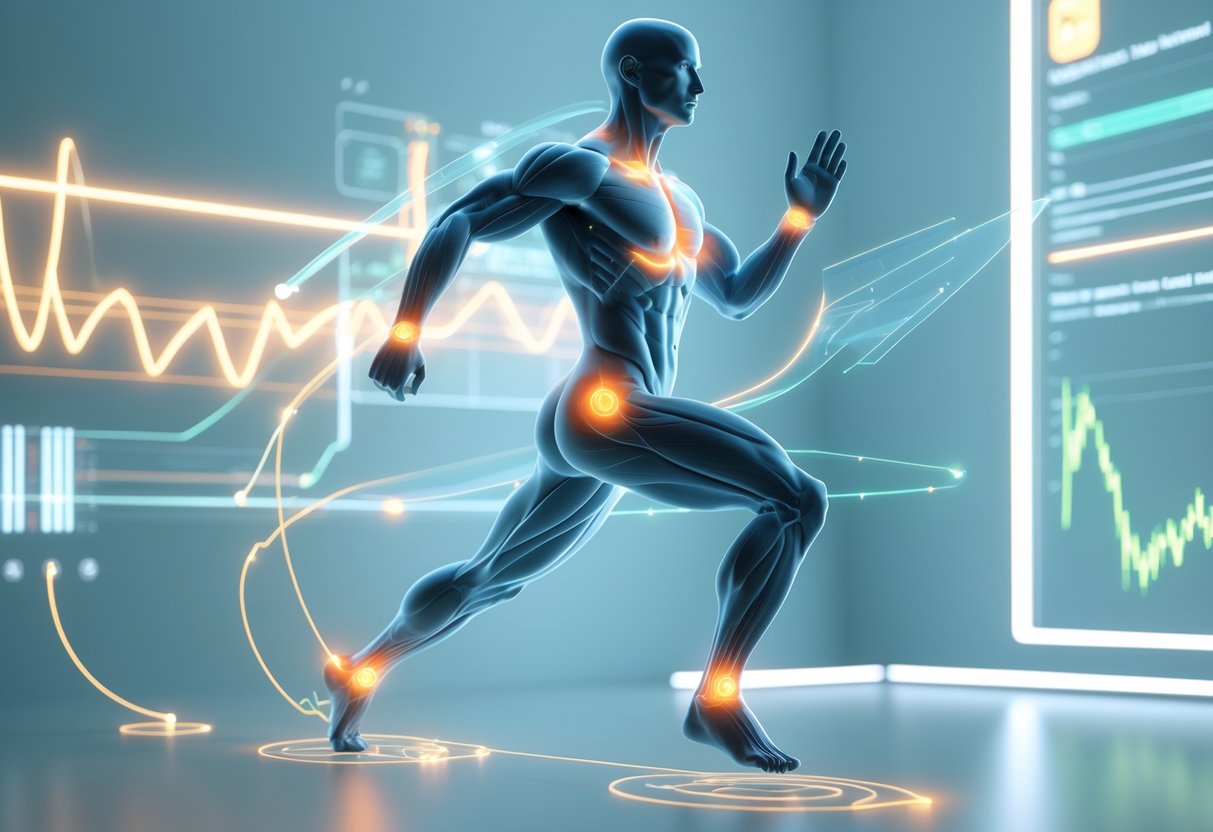
Movement efficiency covers biomechanics, practical work strategies, and even digital transport tricks. Here are some common questions about boosting physical performance, streamlining work, and making things more efficient in different areas.
How can one improve their biomechanical efficiency during physical activity?
We’d suggest starting with good form before cranking up intensity or weight. Stick with basic moves like squats, lifts, and walking to build a solid base.
Stay mindful—pay attention to your breathing and posture. That body awareness goes a long way.
Work on your flexibility with regular stretching. Better range of motion means you’ll move more efficiently and waste less energy.
Consider a functional movement screen to spot imbalances early. Fixing these now stops bad habits from sticking around.
What are some successful strategies for enhancing industrial efficiency through movement?
Cut out unnecessary steps and extra movement between workstations. Map out your process and look for bottlenecks or repeated actions.
Lean manufacturing is all about cutting waste—less inventory, less waiting, less overproduction.
Ergonomic workplace design helps reduce worker fatigue and injuries. Putting tools in the right spot and setting the right workstation height makes a big difference.
Teach employees efficient movement for their specific jobs. Regular training keeps everyone sharp.
Could you explain the role of water currents in optimising transportation in Minecraft?
Water currents in Minecraft let you build super-efficient transport for players and items. Flowing water pushes things in predictable ways at steady speeds.
Soul sand bubble columns lift you or your gear up, while magma blocks pull you down. You can go vertical without redstone or powered rails.
Ice boats on water are the speediest way to travel in the overworld. Blue ice is even faster for long hauls.
Item sorters and farms use water streams to move resources automatically. That way, you spend less time collecting and more time building.
What examples illustrate the successful fostering of efficiency in the workplace?
Toyota’s production system changed manufacturing with just-in-time delivery and constant improvement. They cut waste without sacrificing quality.
Digital workflow tools help teams keep track and avoid communication hiccups. Project management software trims down meetings and streamlines teamwork.
Cross-training makes your workforce more flexible, so you’re less stuck when someone’s away.
Regular efficiency audits point out what needs fixing and help track progress. Data-driven tweaks keep things moving forward.
Who have been key figures and groups in the movement for industrial efficiency?
Frederick Winslow Taylor led the way with scientific management in the early 1900s. His time-and-motion studies shaped how we think about efficiency.
Henry Ford’s assembly line changed the game for manufacturing, making mass production possible and affordable.
The Lean Manufacturing movement, inspired by Toyota, focuses on cutting waste and always improving. It’s spread far beyond car factories.
W. Edwards Deming pushed for quality management and employee involvement. His ideas made processes more efficient and products better.
Is there a formula that accurately represents human efficiency in various tasks?
Honestly, there’s no single formula that nails human efficiency for every task out there. People are just too different, and every job has its own quirks.
Factors like skill level, how tired you are, or even the room temperature can totally change how efficient someone is.
Some folks use work measurement techniques, like predetermined motion time systems, to estimate efficiency for specific activities. These systems break tasks into simple movements and then assign time values to each one.
Metabolic equivalent (MET) values also come into play. They measure how much energy you burn during different physical activities, which makes it easier to compare how efficient certain exercises or work tasks are.
Performance metrics? Well, they look different depending on the industry or the job itself. That’s why people usually stick to task-specific measurements and just keep tweaking things to get better results.

